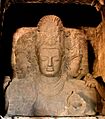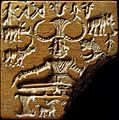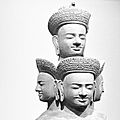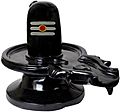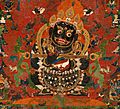Shiva facts for kids
Quick facts for kids Shiva |
|
|---|---|
| Supreme Being; Lord of Divine Energy, Meditation, Arts, Yoga, Time, Destruction, Dance; Supreme Destroyer of Evil; Lord of The Devas (gods); | |
| Member of Trimurti | |
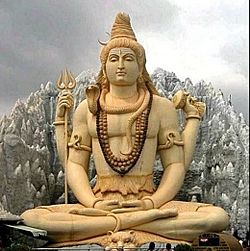
Statue of Shiva in the lotus position at Shivoham Temple
|
|
| Other names | Mahesha, Shankara, Bholenath, Neelkanth, Mahadeva |
| Affiliation | Parabrahman (Shaivism), Trimurti, Paramatman, Ishvara, Deva |
| Abode | Mount Kailash |
| Mantra | Om Namah Shivaya |
| Weapon | Pashupatastra, Trident, Parashu-Axe, Pinaka bow |
| Symbols | Lingam, Trident, Crescent Moon, Damaru Drum |
| Mount | Nandi (bull) |
| Festivals | Shraavana, Maha Shivaratri, Ekadashi, Kartik Purnima, Bhairava Ashtami |
| Personal information | |
| Consort | Parvati (Adi Parashakti, Sati, Durga, Kali, Mahakali) |
| Children | Ganesha, Kartikeya, Ashokasundari Regional: Ayyappa |
Shiva is one of the three main gods in Hinduism. Shiva is known as the destroyer god because he removes all evil from the world. His wife is the goddess Parvati. He has a blue neck because, according to Hindu legend, he swallowed a poison in order to save the universe. He has three eyes, the third eye is on his forehead. Shiva is one third of the Hindu trinity including Brahma and Vishnu. Lord Shiva lives in the Himalayas. Ganesha and Kartikeya are his sons.
Shiva is regarded as the patron god of yoga, meditation and the arts. The iconographical attributes of Shiva are the serpent king Vasuki around his neck, the adorning crescent moon, the holy river Ganga flowing from his matted hair, the third eye on his forehead (the eye that turns everything in front of it into ashes when opened), the trishula or trident as his weapon, and the damaru.
Shiva as we know him today shares many features with the Vedic god Rudra, and both Shiva and Rudra are viewed as the same personality in Hindu scriptures. The two names are used synonymously.
Contents
Shaivism
Shaivism is one of the four major sects of Hinduism, the others being Vaishnavism, Shaktism and the Smarta Tradition. Followers of Shaivism, called "Shaivas", revere Shiva as the Supreme Being. Shaivas believe that Shiva is All and in all, the creator, preserver, destroyer, revealer and concealer of all that is. He is not only the creator in Shaivism, but he is also the creation that results from him, he is everything and everywhere. Shiva is the primal Self, the pure consciousness and Absolute Reality in the Shaiva traditions. Shiva is also Part of 'Om' (ॐ) as a 'U' (उ).
Attributes

- Third eye: Shiva is often depicted with a third eye, with which he burned Desire (Kāma) to ashes, called "Tryambakam" (Sanskrit: त्र्यम्बकम्), which occurs in many scriptural sources. In classical Sanskrit, the word ambaka denotes "an eye", and in the Mahabharata, Shiva is depicted as three-eyed, so this name is sometimes translated as "having three eyes". However, in Vedic Sanskrit, the word ambā or ambikā means "mother", and this early meaning of the word is the basis for the translation "three mothers". These three mother-goddesses who are collectively called the Ambikās. Other related translations have been based on the idea that the name actually refers to the oblations given to Rudra, which according to some traditions were shared with the goddess Ambikā.
- Crescent moon: Shiva bears on his head the crescent moon. The epithet Candraśekhara (Sanskrit: चन्द्रशेखर "Having the moon as his crest" – candra = "moon"; śekhara = "crest, crown") refers to this feature. The placement of the moon on his head as a standard iconographic feature dates to the period when Rudra rose to prominence and became the major deity Rudra-Shiva. The origin of this linkage may be due to the identification of the moon with Soma, and there is a hymn in the Rig Veda where Soma and Rudra are jointly implored, and in later literature, Soma and Rudra came to be identified with one another, as were Soma and the moon.
- Ashes: Shiva iconography shows his body covered with ashes (bhasma, vibhuti). The ashes represent a reminder that all of material existence is impermanent, comes to an end becoming ash, and the pursuit of eternal Self and spiritual liberation is important.
- Matted hair: Shiva's distinctive hair style is noted in the epithets Jaṭin, "the one with matted hair", and Kapardin, "endowed with matted hair" or "wearing his hair wound in a braid in a shell-like (kaparda) fashion". A kaparda is a cowrie shell, or a braid of hair in the form of a shell, or, more generally, hair that is shaggy or curly.
- Blue throat: The epithet Nīlakaṇtha (Sanskrit नीलकण्ठ; nīla = "blue", kaṇtha = "throat"). Since Shiva drank the Halahala poison churned up from the Samudra Manthana to eliminate its destructive capacity. Shocked by his act, Parvati squeezed his neck and stopped it in his neck to prevent it from spreading all over the universe, supposed to be in Shiva's stomach. However the poison was so potent that it changed the color of his neck to blue. This attribute indicates that one can become Shiva by swallowing the worldly poisons in terms of abuses and insults with equanimity while blessing those who give them.
- Meditating yogi: his iconography often shows him in a Yoga pose, meditating, sometimes on a symbolic Himalayan Mount Kailasa as the Lord of Yoga.
- Sacred Ganga: The epithet Gangadhara, "Bearer of the river Ganga" (Ganges). The Ganga flows from the matted hair of Shiva. The Gaṅgā (Ganga), one of the major rivers of the country, is said to have made her abode in Shiva's hair.
- Tiger skin: Shiva is often shown seated upon a tiger skin.
- Vasuki: Shiva is often shown garlanded with the serpent Vasuki.Vasuki is the second king of the nāgas (the first being Vishnu's mount, Shesha). According to a legend, Vasuki was blessed by Shiva and worn by him as an ornament after the Samudra Manthana.
- Trident: Shiva typically carries a trident called Trishula. The trident is a weapon or a symbol in different Hindu texts. As a symbol, the Trishul represents Shiva's three aspects of "creator, preserver and destroyer", or alternatively it represents the equilibrium of three guṇas of sattva, rajas and tamas.
- Drum: A small drum shaped like an hourglass is known as a damaru. This is one of the attributes of Shiva in his famous dancing representation known as Nataraja. A specific hand gesture (mudra) called ḍamaru-hasta (Sanskrit for "ḍamaru-hand") is used to hold the drum. This drum is particularly used as an emblem by members of the Kāpālika sect.
- Axe (Parashu) and Deer are held in Shiva's hands in Odisha & south Indian icons.
- Rosary beads: he is garlanded with or carries a string of rosary beads in his right hand, typically made of Rudraksha. This symbolises grace, mendicant life and meditation.
- Nandī: Nandī, (Sanskrit: नन्दिन् (nandin)), is the name of the bull that serves as Shiva's mount. Shiva's association with cattle is reflected in his name Paśupati, or Pashupati (Sanskrit: पशुपति), translated by Sharma as "lord of cattle" and by Kramrisch as "lord of animals", who notes that it is particularly used as an epithet of Rudra.
- Mount Kailāsa: Kailasa in the Himalayas is his traditional abode. In Hindu mythology, Mount Kailāsa is conceived as resembling a Linga, representing the center of the universe.
- Gaṇa: The Gaṇas are attendants of Shiva and live in Kailash. They are often referred to as the bhutaganas, or ghostly hosts, on account of their nature. Generally benign, except when their lord is transgressed against, they are often invoked to intercede with the lord on behalf of the devotee. His son Ganesha was chosen as their leader by Shiva, hence Ganesha's title gaṇa-īśa or gaṇa-pati, "lord of the gaṇas".
- Varanasi: Varanasi (Benares) is considered to be the city specially loved by Shiva, and is one of the holiest places of pilgrimage in India. It is referred to, in religious contexts, as Kashi.
Images for kids
-
An ancient sculpture of Shiva at the Elephanta Caves, Maharashtra. 6th century CE
-
The Pashupati seal discovered during excavation of the Indus Valley archaeological site of Mohenjo-Daro and showing a possible representation of a "yogi" or "proto-Shiva" figure as Paśupati (Lord of the Animals" c. 2350-2000 BCE
-
Oleograph by Raja Ravi Varma depicting a Shiva-centric Panchayatana. A bearded Shiva sits in the centre with his wife Parvati and their infant son Ganesha; surrounded by (clockwise from left upper corner) Ganesha, Devi, Vishnu, and Surya. Shiva's mount is the bull Nandi below Shiva.
-
Shiva is depicted both as an ascetic yogi, and as a householder with goddess Parvati.
-
Chola dynasty statue depicting Shiva dancing as Nataraja (Los Angeles County Museum of Art)
-
Shiva Lingam with tripundra
-
Mahakala, c. 1500 CE Tibetan Thangka
-
Statue of Shiva depicted as a Chinese Buddhist deva on Mount Putuo Guanyin Dharma Realm in Zhejiang, China
See also
 In Spanish: Shiva para niños
In Spanish: Shiva para niños




